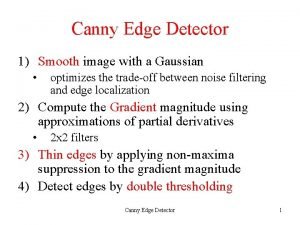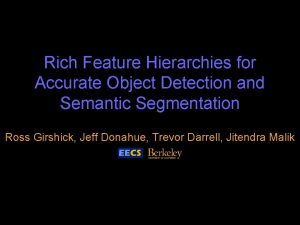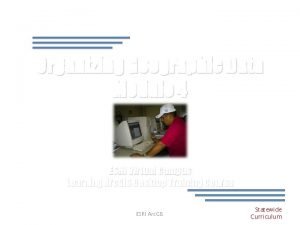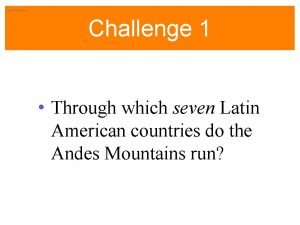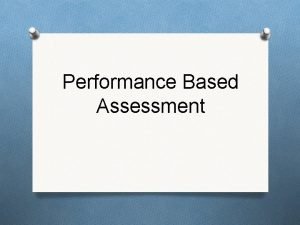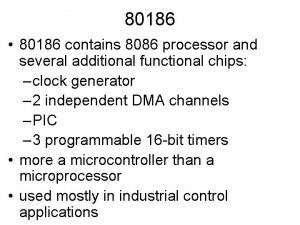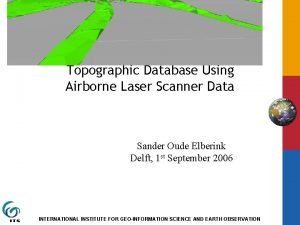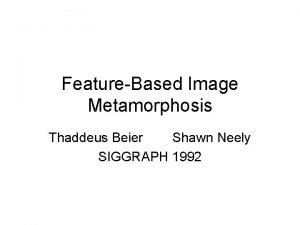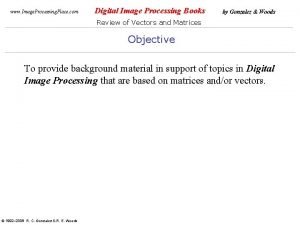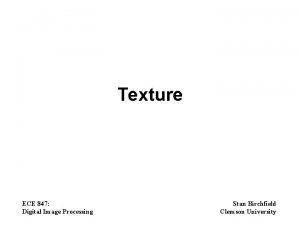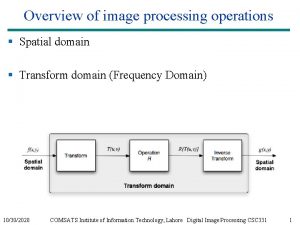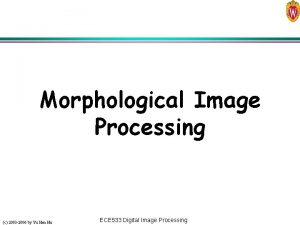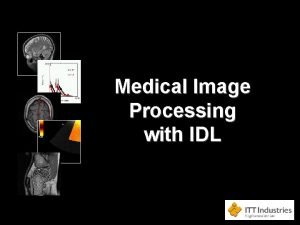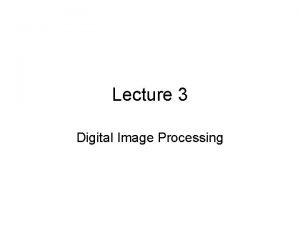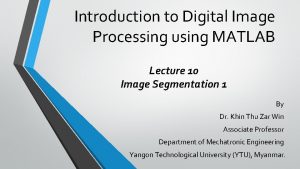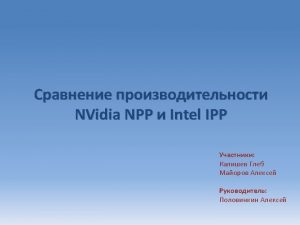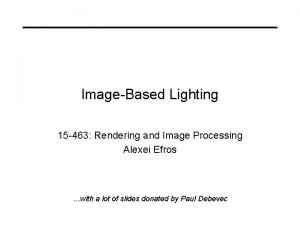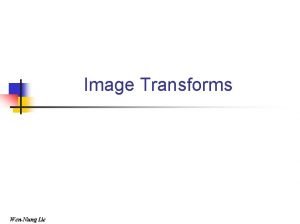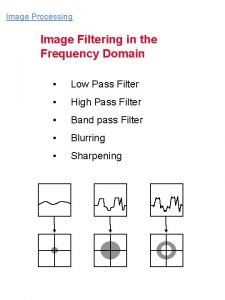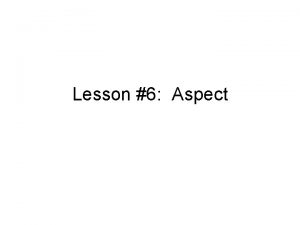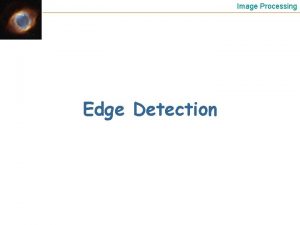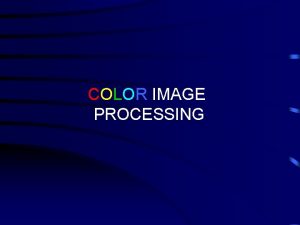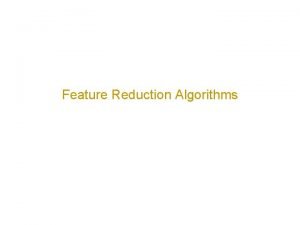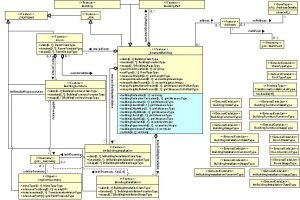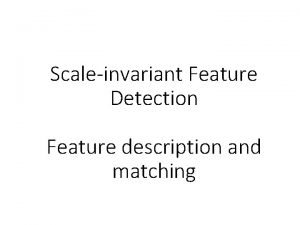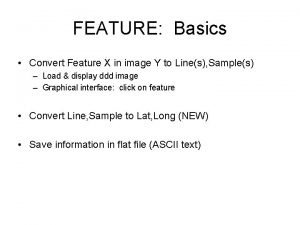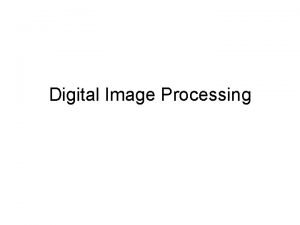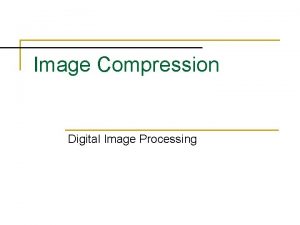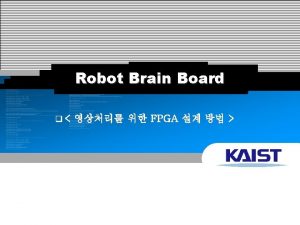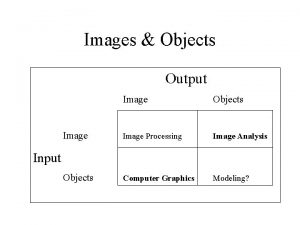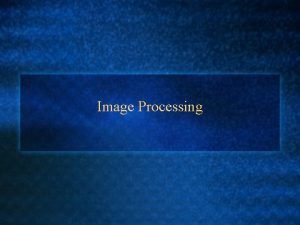Feature detection An Important aspect of Image Processing

























































- Slides: 57

Feature detection An Important aspect of Image Processing Hasna O. & Mentor- Dr Man 1

A picture is worth more than a thousand words Image analysis (a. k. a. understanding), image processing & computer vision plays an important role in society today because A picture gives a much clearer impression of a situation or an object Having an accurate visual perspective of things has a high social, technical and economic value 2

Digital image perception is used for: Improving pictorial information for human perception Processing of image data for storage, transmission and representation for autonomous machine perception. 3

Image Processing is to perform numerical operations on higher dimensional signals such as images and video sequences. The objectives of image processing include: – Improving the appearance of the visual data image enhancement, image restoration – Extracting useful information image analysis, reconstruction from projection – Representing the image in an alternate and possibly more efficient form transformation, image compression 4

Visible Human Project The Visible Human Project was an effort of the National Library of Medicine (NLM) to build a digital image library of volumetric data representing a complete, normal adult male and female. The data sets were 5 released in 1994 and

Visible Human Project Photo MRI CT 6

What is Digital Image Processing? 7

The field of digital image processing refers to processing digital images by means of a digital computer. A digital image composes of a finite number of elements which have a particular location and value and these elements are referred to as picture elements, image elements, pels and pixels. Digital Image: a two dimensional array of pixels. –Size (or resolution) of an image: width: N pixels, height: M pixels. –Precision of pixels: 2 n amplitude levels n bits per pixel. –Overall data file size: N M n bits 8

Image Example LENA, 512 x 512, true color (24 b/p), 786432 bytes. 9

Images are referred to more than just the projections generated by the visual band of the EM (electromagnetic) waves apparent to humans. Images generated from the entire band of the EM waves ranging from gamma to radio waves can be perceived by imaging machines. Some of these images include ultrasound, electron microscopy, and computer-generated images. 10

Image Examples Size: 2048 x 2560 11

Graphic Example 12

Video Example AKIYO, 352 x 288 (CIF), 24 b/p, 30 f/s, 72. 99 Mbits/s. 13

Animation Example 14

There are 3 computerized processing levels: Low-level process: - is characterized by the fact that both the inputs and outputs are images. These involve primitive operations such as image preprocessing to reduce noise, contrast enhancement and image sharpening. Mid-level process: - is characterized by the fact that its inputs generally are images, but its outputs are attributes extracted from those images such as, edges, contours, and the identity of individual objects. Mid-level processing on images involves tasks such as segmentation (partitioning an image into regions or objects), description of those objects to reduce them to a form suitable for computer processing, and classification (recognition) of individual objects. High-level process: - involves trying deduce an ensemble of recognized objects, from image analysis to performing the cognitive function usually associated with vision. 15

Origins of Digital Image Processing 16

In the early 1920’s the Bartlane cable picture transmission system was introduced, thereby reducing the transportation time for a picture from New York to England by days. Digital images were first applied in the newspaper industry when pictures were first set by submarine cable between London and New York, then the Bartlane cable was introduced reducing transmission time from three weeks to three hours. There were different phases in technology improvement; in 1921 the method used for receiving images through a coded tape by a telegraph printer was abandoned in favor of a technique based on photographic reproduction made from tapes perforated at the telegraph receiving terminal with evident improvement in both tonal quality and resolution. 17

The history of digital image processing is intimately tied to the development of the digital computer. The first computers powerful enough to carry out meaningful image processing tasks appeared in the early 1960 s. This was when there was significant development of the high-level programming languages COBOL (common business-oriented language) and FORTRAN (formula translator) and the development of operating systems. The birth of digital image processing can be traced to the availability of advanced computers and the onset of the space program during that period. Work on using computer techniques for improving images from a space probe began at the Jet Propulsion Laboratory in Pasadena, California in 1964 when pictures of the moon transmitted by RANGER 7 were processed by a computer to correct various types of image distortion inherent in the on-board television camera. 18

Fields that use Digital Image Processing In parallel with space applications, DIP is used in * Medical Imaging * Earth Resources observations * Astronomy 19

Medical Imaging (extracted from Dr. Man’s Presentation) Medical imaging is a rich field with multidiscipline nature, involving nuclear physics, quantum mechanics, fluid dynamics, advanced mathematics, biology, chemistry, computer science and computer engineering. It has become a primary component of modern medicine. It is still a relatively new field with many unknown effects and unanswered questions. The technologies are evolving, and new equipment, modality, study methodology have been constantly developed. Excellent opportunities for research and career development. 20

Medical Imaging The invention in the early 1970 s of computerized axial tomography (CAT) is one of the most important events in the application of image processing in medical diagnosis. Tomography consists of algorithms that use the sensed data to construct an image that represents a slice through the object which compose a threedimensional (3 -D) version of the inside of the object. 21

X-ray CT 22

CONTINUED Tomography was invented independently by Sir Godfrey N. Hounsfield and Professor Allan M. Cormack, who shared the 1979 Nobel Prize in Medicine for their invention. X-rays were discovered in 1895 by Wilhelm Conrad Roentgen, for which he received the 1901 Nobel Prize in Physics. These two inventions, nearly 100 years apart led to some of the most active application areas of image processing today. Computer procedures are also used to enhance the contrast or code the intensity levels into color for easier interpretation of Xrays and other images used in industry, medicine, and the biological sciences. 23

Computed Tomography Besides the natural images acquired from conventional optical cameras, computer synthesized images become more and more important in many application fields. Non-invasive imaging modalities allow people to view objects that can not be seen by human eye or camera, – Internal organ of human body, – Damaged part inside an airplane wing, – Cloud covered city, – Dark night battle field, – Underground oil field… 24

Projection X-Ray 25

First X-ray The hand of Mrs. Wilhelm Roentgen: the first X-ray image, 1895 (http: //www. nlm. nih. gov/exhibition/dreamana tomy/da_g_Z-1. html) 26

For Mammography Detection and diagnosis of breast cancer based on some of the basis of these signs made visible by Image Processing Architectural distortions of normal tissue patterns Asymmetry between corresponding regions of the images on the right and left breast. 27

Mammography 28

Remote Earth Resources and Observations Geographers use the same or similar techniques to study pollution patterns from aerial and satellite imagery. Image enhancement and restoration procedures are used to process degraded images of unrecoverable objects or experimental results too expensive to duplicate. In archaeology, image processing methods have successfully restored blurred pictures that were the only available records of rare artifacts lost or damaged after being photographed. 29

In physics and other related fields, computer techniques routinely enhance images of experiments in areas such as high-energy plasmas and electron microscopy. Similarly successful applications of image processing concepts can be found in astronomy, biology, nuclear medicine, law enforcement defense, and industrial applications. These examples illustrate processing results intended for human interpretation. The second major area of application of digital image processing techniques deals with machine perception. In this case interest focuses on procedures for extracting from an image, information in a form suitable for computer processing. Examples of the type of information used in machine perception are statistical moments, Fourier transform coefficients, and multidimensional distance measures. Typical problems in machine perception that routinely utilize image processing techniques are automatic character recognition, industrial machine vision for product assembly and inspection, military recognizance, automatic processing of fingerprints, screening of X-rays and blood samples, and machine processing of aerial and satellite imagery for weather prediction and environmental assessment. 30

Fundamental Steps in DIP Image acquisition- is the first process which involves preprocessing such as scaling. Image enhancement- this is bringing out obscured detail or highlighting certain features of interest in an image. This technique deals with a number of mathematical functions such as the Fourier Transform. Image restoration- it improves the appearance of an image but is objective in the sense that this technique tends to be based on mathematical or probabilistic models of image degradation. Color image processing- this is used as a basis for extracting features of interest in an image. 31

Wavelets- are the foundation for representing images in various degrees of resolution. Compression- deals with techniques for reducing the storage required to save an image, or the bandwidth required to transmit it. Morphological processing- deals with tools for extracting image components that are useful in the representation and description of shape. Segmentation- partitions an image into its constituent parts or objects. Representation and description- representation is necessary for transforming raw data into a form suitable for subsequent computer processing. Description, also known as feature selection, deals with extracting attributes that result in some quantitative information of interest. Recognition- assigns a label to an object based on its descriptors. Feature Extraction- this is an area of image processing which involves using algorithms to detect and isolate various desired portions of a digitized image or video stream. 32

Image Enhancement 33

Histogram Example Original 34

Histogram Example (cont. ) Poor contrast 35

Histogram Example (cont. ) Poor contrast 36

Histogram Example (cont. ) Enhanced contrast 37

Smoothing and Sharpening Examples Smoothing Sharpening 38

Smoothing and Sharpening Examples Smoothing Sharpening 39

Image Analysis 40

Image analysis is to identify and extract useful information from an image or a video scene, typically with the ultimate goal of forming a decision. Image analysis is the center piece of many applications such as remote sensing, robotic vision and medical imaging. Image analysis generally involves basic operations: – Pre-processing, – Object representation, – Feature detection, – Classification and interpretation. 41

Image Segmentation 42

Image segmentation is an important pre-processing tool. It produces a binary representation of the object with features of interest such as shapes and edges. Common operations include: Thresholding: to segment an object from its background through a simple pixel amplitude based decision. Complicated thresholding methods may be used when the background is not homogeneous. Edge detection: to identify edges of an object through a set of high-pass filtering. Directional filters and adaptive filters are frequently used to achieve reliable results. 43

Segmentation Examples 44 Thresholding Edge detection

Feature Extraction This is an area of image processing that uses algorithms to detect and isolate various desired portions of a digitized image. 45

What is a Feature? A feature is a significant piece of information extracted from an image which provides more detailed understanding of the image. 46

Examples of Feature Detections Detecting of faces in an image filled with people and other objects Detecting of facial features such as eyes, nose, mouth Detecting of edges, so that a feature can be extracted and compared with another 47

Feature Detection and Classification 48

Feature Detection and Classification 49 • Feature detection is to identify the presence of a certain type of feature or object in an image. • Feature detection is usually achieved by studying the statistic variations of certain regions and their backgrounds to locate unusual activities. • Once an interesting feature has been detected, the representation of this feature will be used to compare with all possible features known to the processor. A statistical classifier will produce a feature type that has the closest similarity (or maximum likelihood) to the testing feature. • Data collection and analysis (or the training process)have to be performed at the classifier before any classification.

Feature Extraction Techniques HOUGH TRANSFORM 50

Each line is represented by two parameters, commonly called r and θ which represent the length and angle from the origin of a normal to the line in question. In other words, a line is said to be 90° from θ and r units away from the origin at its closest point. By calculating the value of r for every possible value of θ, a sinusoidal curve is created which is unique to that point. This representation of the two parameters is sometimes referred to as Hough space. 51

Thus the points to be transformed are likely to lie on an ‘edge’ in the image. The transform itself is quantized into an arbitrary number of bins, each representing an approximate definition of a possible line. Each significant point (or feature) in the edge detected is said to vote for a set of bins corresponding to the lines that pass through it. By simply incrementing the value stored in each bin for every feature lying on that line, an array is built up which shows which lines fit most closely to the data in the image. 52

Hough Transform of Curves, and Generalized Hough Transform The transform described above applies to finding straight lines; a circle for instance can be transformed into a set of three parameters representing its center and radius, so that the Hough space becomes three dimensional. Arbitrary ellipses, curves and shapes expressed as a set of parameters can be found this way. For more complicated shapes, the Generalized Hough transform is used, which allows a feature to vote for particular position, orientation and/scaling or the shape using a predefined look -up table. 53

Using Weighted Features The Hough transform accounts for uncertainty in the underlying detection of edges by allowing features to vote with varying weight. 54

Hierarchical Hough Transform A final enhancement that is sometimes effective is to perform a hierarchical set of Hough transform on the same image, using progressively smaller bins. If the image is first analyzed using a small number of bins, each representing a large range of potential lines, the most likely of these can then be analyzed in more detail. That is finding the bins with the highest count in one stage can be used to constrain the range of values searched in the text. 55

REFERENCES The data in this documentation has been quoted, cited and extracted from the following sources: Introduction to medical Imaging & Instrumentation – Hong Man The Art of Image Processing (operators and applications – Hong Man Digital Image Processing – Rafael C. Gonzalez, Richard E. Woods Wikipedia. org 56

Cont. d Handbook of Image and Video Processor – Al Bovik A New Approach to Image Feature Detection with Applications – BS Manjunath 57
 Le texte descriptif
Le texte descriptif What is canny edge detection in image processing
What is canny edge detection in image processing Curve detection in image processing
Curve detection in image processing Unsharp masking matlab
Unsharp masking matlab What is point processing in digital image processing
What is point processing in digital image processing Histogram processing in digital image processing
Histogram processing in digital image processing Nonlinear image processing
Nonlinear image processing پردازش تصویر
پردازش تصویر Morphological
Morphological Insight learning is oftentimes an important aspect of
Insight learning is oftentimes an important aspect of An important aspect of changing trends in occupation is
An important aspect of changing trends in occupation is Image transform in digital image processing
Image transform in digital image processing What is image restoration in digital image processing
What is image restoration in digital image processing Compression models in digital image processing
Compression models in digital image processing Image segmentation in digital image processing
Image segmentation in digital image processing Variable length coding in digital image processing
Variable length coding in digital image processing Image sharpening and restoration
Image sharpening and restoration Image geometry in digital image processing
Image geometry in digital image processing Zooming and shrinking in digital image processing
Zooming and shrinking in digital image processing Image transform in digital image processing
Image transform in digital image processing Maketform matlab
Maketform matlab Image restoration in digital image processing
Image restoration in digital image processing Rich feature hierarchies for accurate object detection
Rich feature hierarchies for accurate object detection Feature dataset vs feature class
Feature dataset vs feature class Isolated feature combined feature effects
Isolated feature combined feature effects What important physical feature is found near 10°n 80°w
What important physical feature is found near 10°n 80°w Assessment is both process and product oriented
Assessment is both process and product oriented 80186
80186 Near-duplicate image detection python
Near-duplicate image detection python Image detection
Image detection Example of a news story
Example of a news story From most important to least important in writing
From most important to least important in writing Least important to most important
Least important to most important Shawn neely
Shawn neely What does this image demonstrate?
What does this image demonstrate? Bottom up and top down processing
Bottom up and top down processing Gloria suarez
Gloria suarez Bottom up processing
Bottom up processing Secondary processing of wheat
Secondary processing of wheat Parallel processing vs concurrent processing
Parallel processing vs concurrent processing Bottom up vs top down processing
Bottom up vs top down processing Batch processing vs interactive processing
Batch processing vs interactive processing Wwwimage
Wwwimage Image processing and analysis stan birchfield pdf
Image processing and analysis stan birchfield pdf Mpp algorithm in image processing
Mpp algorithm in image processing Seed fill algorithm in computer graphics
Seed fill algorithm in computer graphics Spatial operations in image processing
Spatial operations in image processing Opening image processing
Opening image processing Idl medical
Idl medical Aliasing image processing
Aliasing image processing Representation and description in digital image processing
Representation and description in digital image processing Face detection viola jones
Face detection viola jones Double thresholding in image processing
Double thresholding in image processing Image.transpose
Image.transpose Renender
Renender Uu
Uu Segmentation in digital image processing
Segmentation in digital image processing High pass filter radiology
High pass filter radiology

